University Assignment: Aboriginal Wellbeing and Mental Health Essay
VerifiedAdded on 2022/09/09
|9
|2085
|15
Essay
AI Summary
This assignment delves into the critical differences between the Aboriginal concept of social and emotional wellbeing (SEWB) and the Western understanding of mental health. It highlights SEWB's holistic approach, encompassing spiritual, social, emotional, and cultural dimensions, in contrast to the often problem-centric and culturally insensitive nature of Western mental health practices. The essay also examines the evolution of Aboriginal Medical Services, emphasizing their role in addressing health service gaps within Indigenous communities and their alignment with the principles of primary health care as outlined by the World Health Organization, particularly focusing on equity, accessibility, and community self-determination. Finally, it describes the practical application of SEWB within Aboriginal Community Controlled Health services, showcasing how these services integrate cultural practices and address the unique needs of Indigenous Australians, acknowledging the historical traumas and promoting healing through community-based approaches. This assignment emphasizes the importance of culturally competent healthcare and the significance of SEWB in improving the overall health and wellbeing of Aboriginal and Torres Strait Islander peoples.
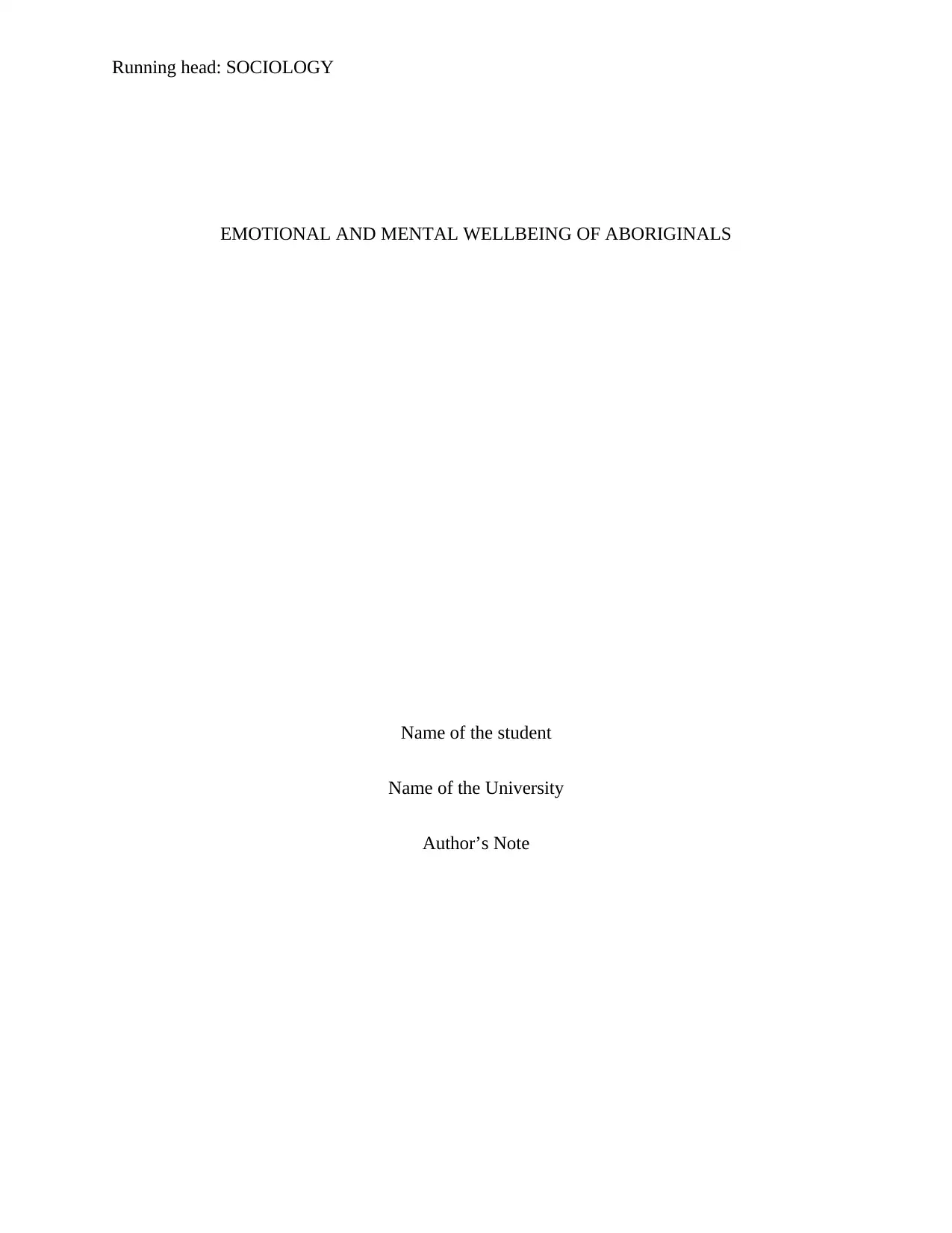
Running head: SOCIOLOGY
EMOTIONAL AND MENTAL WELLBEING OF ABORIGINALS
Name of the student
Name of the University
Author’s Note
EMOTIONAL AND MENTAL WELLBEING OF ABORIGINALS
Name of the student
Name of the University
Author’s Note
Paraphrase This Document
Need a fresh take? Get an instant paraphrase of this document with our AI Paraphraser
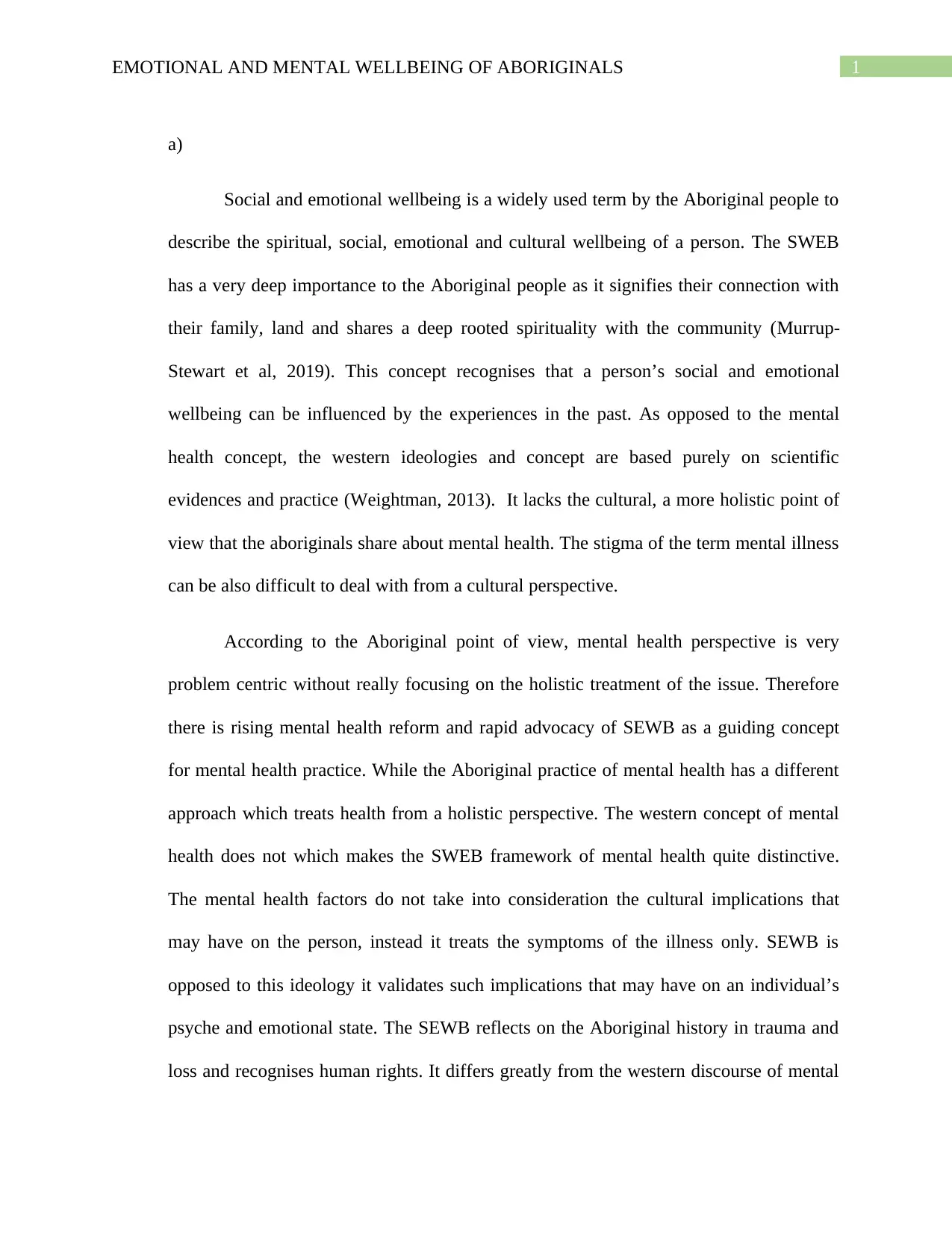
1EMOTIONAL AND MENTAL WELLBEING OF ABORIGINALS
a)
Social and emotional wellbeing is a widely used term by the Aboriginal people to
describe the spiritual, social, emotional and cultural wellbeing of a person. The SWEB
has a very deep importance to the Aboriginal people as it signifies their connection with
their family, land and shares a deep rooted spirituality with the community (Murrup‐
Stewart et al, 2019). This concept recognises that a person’s social and emotional
wellbeing can be influenced by the experiences in the past. As opposed to the mental
health concept, the western ideologies and concept are based purely on scientific
evidences and practice (Weightman, 2013). It lacks the cultural, a more holistic point of
view that the aboriginals share about mental health. The stigma of the term mental illness
can be also difficult to deal with from a cultural perspective.
According to the Aboriginal point of view, mental health perspective is very
problem centric without really focusing on the holistic treatment of the issue. Therefore
there is rising mental health reform and rapid advocacy of SEWB as a guiding concept
for mental health practice. While the Aboriginal practice of mental health has a different
approach which treats health from a holistic perspective. The western concept of mental
health does not which makes the SWEB framework of mental health quite distinctive.
The mental health factors do not take into consideration the cultural implications that
may have on the person, instead it treats the symptoms of the illness only. SEWB is
opposed to this ideology it validates such implications that may have on an individual’s
psyche and emotional state. The SEWB reflects on the Aboriginal history in trauma and
loss and recognises human rights. It differs greatly from the western discourse of mental
a)
Social and emotional wellbeing is a widely used term by the Aboriginal people to
describe the spiritual, social, emotional and cultural wellbeing of a person. The SWEB
has a very deep importance to the Aboriginal people as it signifies their connection with
their family, land and shares a deep rooted spirituality with the community (Murrup‐
Stewart et al, 2019). This concept recognises that a person’s social and emotional
wellbeing can be influenced by the experiences in the past. As opposed to the mental
health concept, the western ideologies and concept are based purely on scientific
evidences and practice (Weightman, 2013). It lacks the cultural, a more holistic point of
view that the aboriginals share about mental health. The stigma of the term mental illness
can be also difficult to deal with from a cultural perspective.
According to the Aboriginal point of view, mental health perspective is very
problem centric without really focusing on the holistic treatment of the issue. Therefore
there is rising mental health reform and rapid advocacy of SEWB as a guiding concept
for mental health practice. While the Aboriginal practice of mental health has a different
approach which treats health from a holistic perspective. The western concept of mental
health does not which makes the SWEB framework of mental health quite distinctive.
The mental health factors do not take into consideration the cultural implications that
may have on the person, instead it treats the symptoms of the illness only. SEWB is
opposed to this ideology it validates such implications that may have on an individual’s
psyche and emotional state. The SEWB reflects on the Aboriginal history in trauma and
loss and recognises human rights. It differs greatly from the western discourse of mental
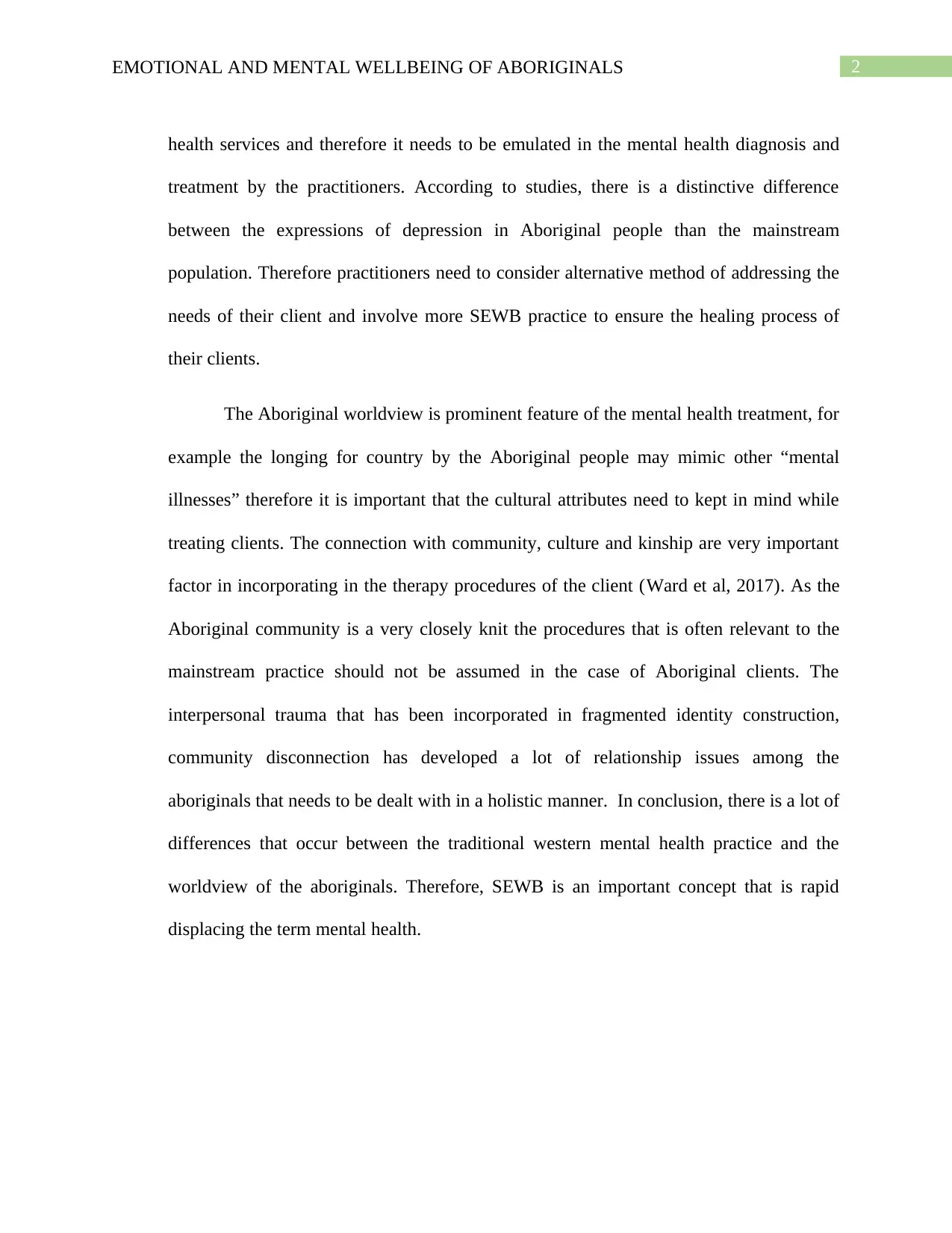
2EMOTIONAL AND MENTAL WELLBEING OF ABORIGINALS
health services and therefore it needs to be emulated in the mental health diagnosis and
treatment by the practitioners. According to studies, there is a distinctive difference
between the expressions of depression in Aboriginal people than the mainstream
population. Therefore practitioners need to consider alternative method of addressing the
needs of their client and involve more SEWB practice to ensure the healing process of
their clients.
The Aboriginal worldview is prominent feature of the mental health treatment, for
example the longing for country by the Aboriginal people may mimic other “mental
illnesses” therefore it is important that the cultural attributes need to kept in mind while
treating clients. The connection with community, culture and kinship are very important
factor in incorporating in the therapy procedures of the client (Ward et al, 2017). As the
Aboriginal community is a very closely knit the procedures that is often relevant to the
mainstream practice should not be assumed in the case of Aboriginal clients. The
interpersonal trauma that has been incorporated in fragmented identity construction,
community disconnection has developed a lot of relationship issues among the
aboriginals that needs to be dealt with in a holistic manner. In conclusion, there is a lot of
differences that occur between the traditional western mental health practice and the
worldview of the aboriginals. Therefore, SEWB is an important concept that is rapid
displacing the term mental health.
health services and therefore it needs to be emulated in the mental health diagnosis and
treatment by the practitioners. According to studies, there is a distinctive difference
between the expressions of depression in Aboriginal people than the mainstream
population. Therefore practitioners need to consider alternative method of addressing the
needs of their client and involve more SEWB practice to ensure the healing process of
their clients.
The Aboriginal worldview is prominent feature of the mental health treatment, for
example the longing for country by the Aboriginal people may mimic other “mental
illnesses” therefore it is important that the cultural attributes need to kept in mind while
treating clients. The connection with community, culture and kinship are very important
factor in incorporating in the therapy procedures of the client (Ward et al, 2017). As the
Aboriginal community is a very closely knit the procedures that is often relevant to the
mainstream practice should not be assumed in the case of Aboriginal clients. The
interpersonal trauma that has been incorporated in fragmented identity construction,
community disconnection has developed a lot of relationship issues among the
aboriginals that needs to be dealt with in a holistic manner. In conclusion, there is a lot of
differences that occur between the traditional western mental health practice and the
worldview of the aboriginals. Therefore, SEWB is an important concept that is rapid
displacing the term mental health.
⊘ This is a preview!⊘
Do you want full access?
Subscribe today to unlock all pages.

Trusted by 1+ million students worldwide
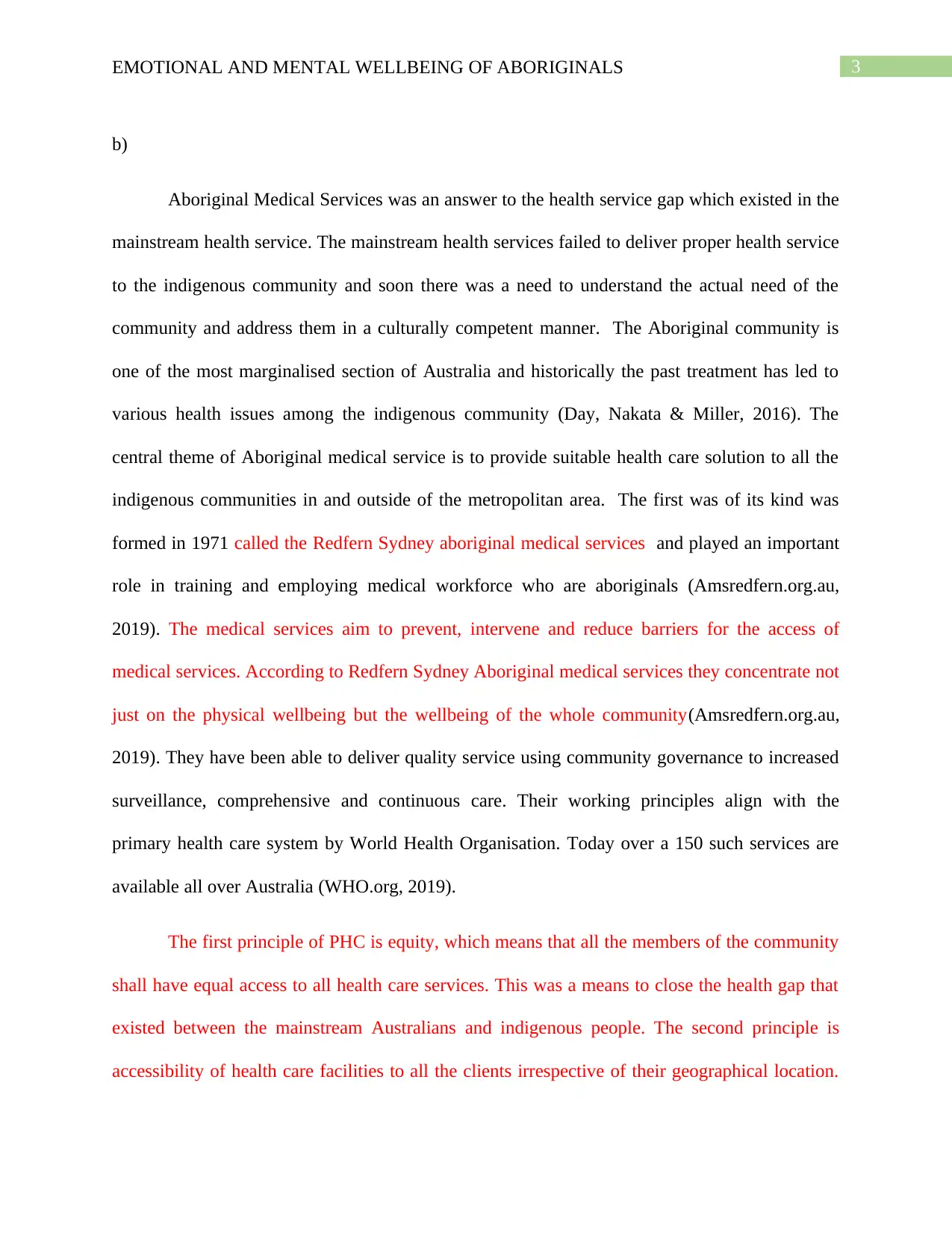
3EMOTIONAL AND MENTAL WELLBEING OF ABORIGINALS
b)
Aboriginal Medical Services was an answer to the health service gap which existed in the
mainstream health service. The mainstream health services failed to deliver proper health service
to the indigenous community and soon there was a need to understand the actual need of the
community and address them in a culturally competent manner. The Aboriginal community is
one of the most marginalised section of Australia and historically the past treatment has led to
various health issues among the indigenous community (Day, Nakata & Miller, 2016). The
central theme of Aboriginal medical service is to provide suitable health care solution to all the
indigenous communities in and outside of the metropolitan area. The first was of its kind was
formed in 1971 called the Redfern Sydney aboriginal medical services and played an important
role in training and employing medical workforce who are aboriginals (Amsredfern.org.au,
2019). The medical services aim to prevent, intervene and reduce barriers for the access of
medical services. According to Redfern Sydney Aboriginal medical services they concentrate not
just on the physical wellbeing but the wellbeing of the whole community(Amsredfern.org.au,
2019). They have been able to deliver quality service using community governance to increased
surveillance, comprehensive and continuous care. Their working principles align with the
primary health care system by World Health Organisation. Today over a 150 such services are
available all over Australia (WHO.org, 2019).
The first principle of PHC is equity, which means that all the members of the community
shall have equal access to all health care services. This was a means to close the health gap that
existed between the mainstream Australians and indigenous people. The second principle is
accessibility of health care facilities to all the clients irrespective of their geographical location.
b)
Aboriginal Medical Services was an answer to the health service gap which existed in the
mainstream health service. The mainstream health services failed to deliver proper health service
to the indigenous community and soon there was a need to understand the actual need of the
community and address them in a culturally competent manner. The Aboriginal community is
one of the most marginalised section of Australia and historically the past treatment has led to
various health issues among the indigenous community (Day, Nakata & Miller, 2016). The
central theme of Aboriginal medical service is to provide suitable health care solution to all the
indigenous communities in and outside of the metropolitan area. The first was of its kind was
formed in 1971 called the Redfern Sydney aboriginal medical services and played an important
role in training and employing medical workforce who are aboriginals (Amsredfern.org.au,
2019). The medical services aim to prevent, intervene and reduce barriers for the access of
medical services. According to Redfern Sydney Aboriginal medical services they concentrate not
just on the physical wellbeing but the wellbeing of the whole community(Amsredfern.org.au,
2019). They have been able to deliver quality service using community governance to increased
surveillance, comprehensive and continuous care. Their working principles align with the
primary health care system by World Health Organisation. Today over a 150 such services are
available all over Australia (WHO.org, 2019).
The first principle of PHC is equity, which means that all the members of the community
shall have equal access to all health care services. This was a means to close the health gap that
existed between the mainstream Australians and indigenous people. The second principle is
accessibility of health care facilities to all the clients irrespective of their geographical location.
Paraphrase This Document
Need a fresh take? Get an instant paraphrase of this document with our AI Paraphraser
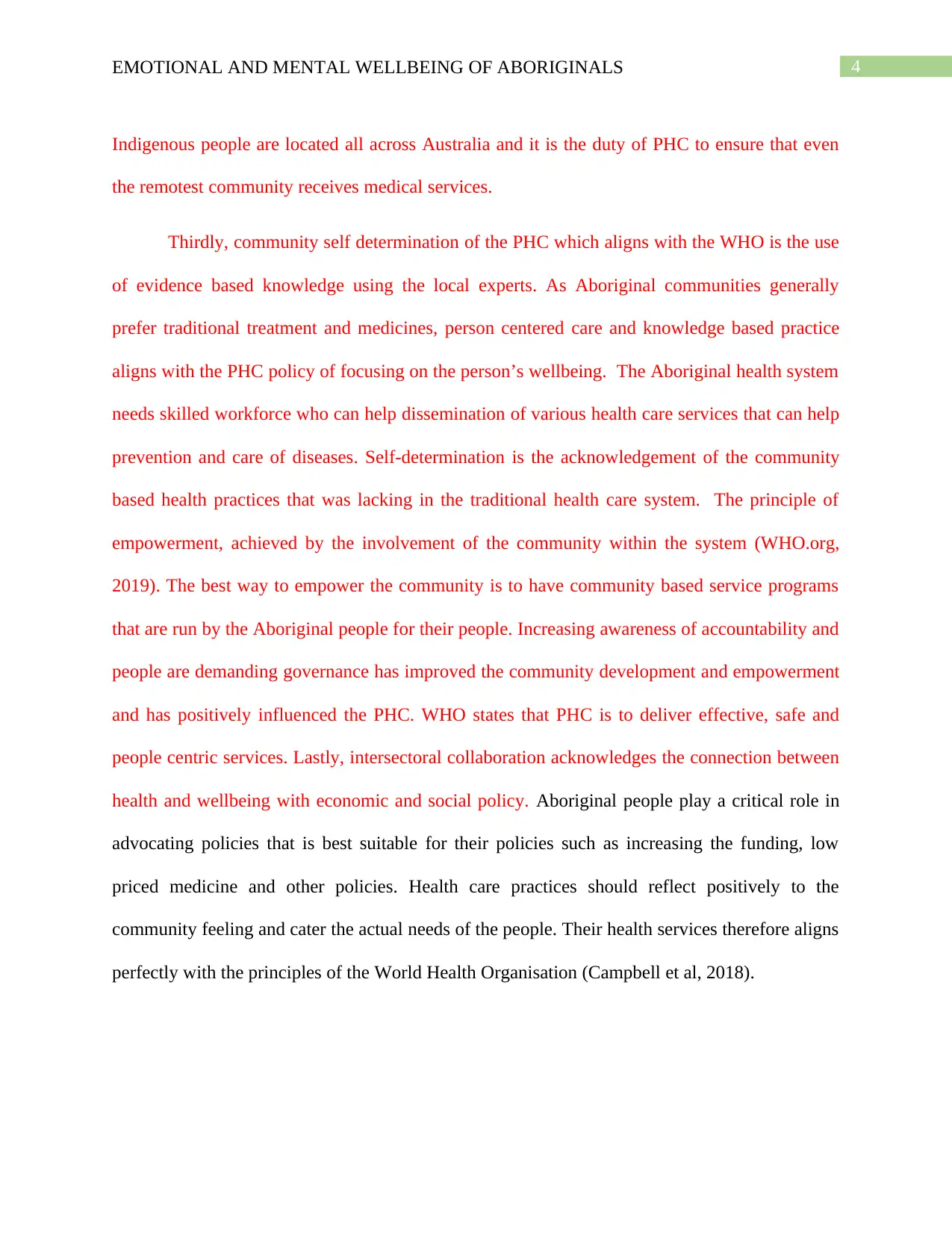
4EMOTIONAL AND MENTAL WELLBEING OF ABORIGINALS
Indigenous people are located all across Australia and it is the duty of PHC to ensure that even
the remotest community receives medical services.
Thirdly, community self determination of the PHC which aligns with the WHO is the use
of evidence based knowledge using the local experts. As Aboriginal communities generally
prefer traditional treatment and medicines, person centered care and knowledge based practice
aligns with the PHC policy of focusing on the person’s wellbeing. The Aboriginal health system
needs skilled workforce who can help dissemination of various health care services that can help
prevention and care of diseases. Self-determination is the acknowledgement of the community
based health practices that was lacking in the traditional health care system. The principle of
empowerment, achieved by the involvement of the community within the system (WHO.org,
2019). The best way to empower the community is to have community based service programs
that are run by the Aboriginal people for their people. Increasing awareness of accountability and
people are demanding governance has improved the community development and empowerment
and has positively influenced the PHC. WHO states that PHC is to deliver effective, safe and
people centric services. Lastly, intersectoral collaboration acknowledges the connection between
health and wellbeing with economic and social policy. Aboriginal people play a critical role in
advocating policies that is best suitable for their policies such as increasing the funding, low
priced medicine and other policies. Health care practices should reflect positively to the
community feeling and cater the actual needs of the people. Their health services therefore aligns
perfectly with the principles of the World Health Organisation (Campbell et al, 2018).
Indigenous people are located all across Australia and it is the duty of PHC to ensure that even
the remotest community receives medical services.
Thirdly, community self determination of the PHC which aligns with the WHO is the use
of evidence based knowledge using the local experts. As Aboriginal communities generally
prefer traditional treatment and medicines, person centered care and knowledge based practice
aligns with the PHC policy of focusing on the person’s wellbeing. The Aboriginal health system
needs skilled workforce who can help dissemination of various health care services that can help
prevention and care of diseases. Self-determination is the acknowledgement of the community
based health practices that was lacking in the traditional health care system. The principle of
empowerment, achieved by the involvement of the community within the system (WHO.org,
2019). The best way to empower the community is to have community based service programs
that are run by the Aboriginal people for their people. Increasing awareness of accountability and
people are demanding governance has improved the community development and empowerment
and has positively influenced the PHC. WHO states that PHC is to deliver effective, safe and
people centric services. Lastly, intersectoral collaboration acknowledges the connection between
health and wellbeing with economic and social policy. Aboriginal people play a critical role in
advocating policies that is best suitable for their policies such as increasing the funding, low
priced medicine and other policies. Health care practices should reflect positively to the
community feeling and cater the actual needs of the people. Their health services therefore aligns
perfectly with the principles of the World Health Organisation (Campbell et al, 2018).
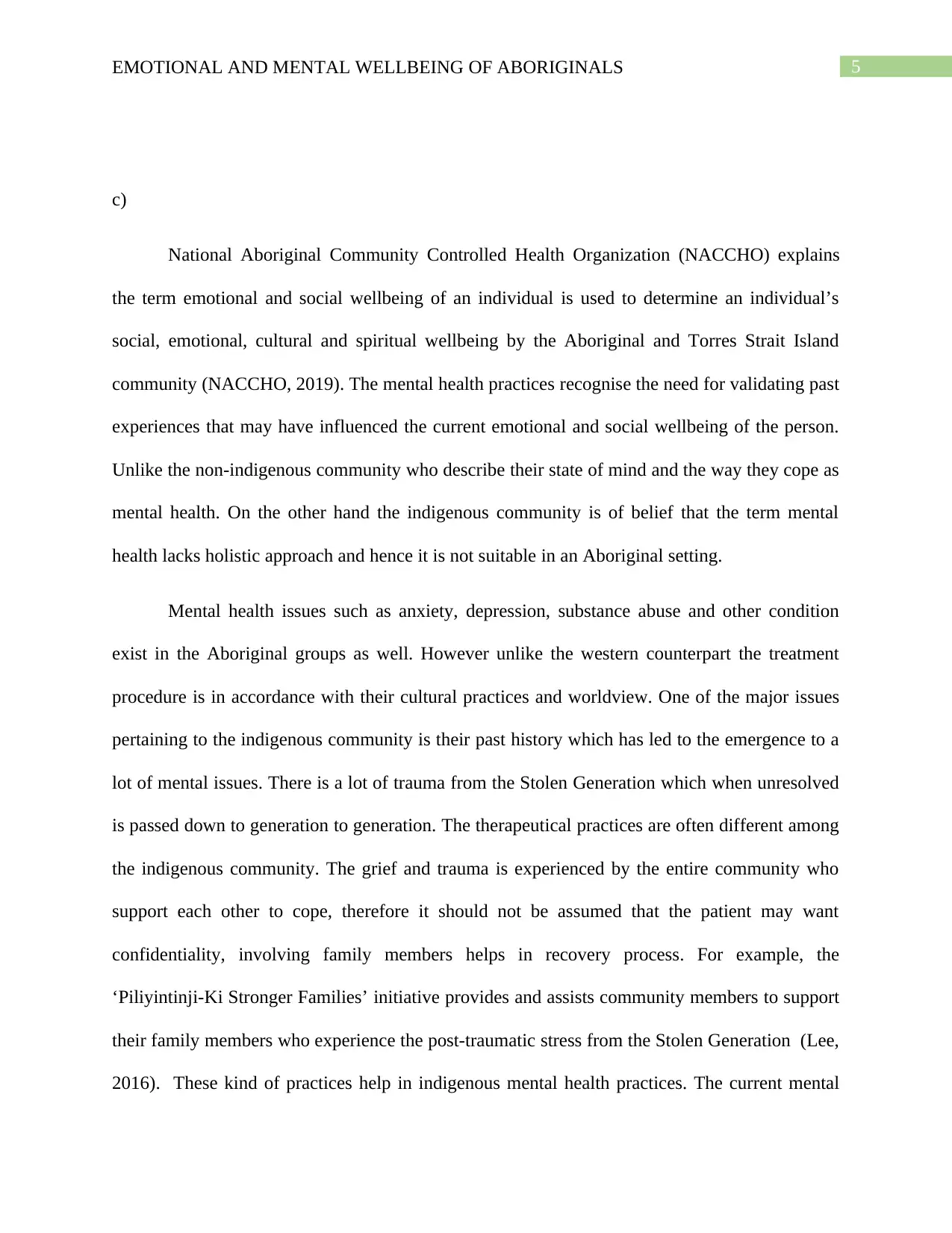
5EMOTIONAL AND MENTAL WELLBEING OF ABORIGINALS
c)
National Aboriginal Community Controlled Health Organization (NACCHO) explains
the term emotional and social wellbeing of an individual is used to determine an individual’s
social, emotional, cultural and spiritual wellbeing by the Aboriginal and Torres Strait Island
community (NACCHO, 2019). The mental health practices recognise the need for validating past
experiences that may have influenced the current emotional and social wellbeing of the person.
Unlike the non-indigenous community who describe their state of mind and the way they cope as
mental health. On the other hand the indigenous community is of belief that the term mental
health lacks holistic approach and hence it is not suitable in an Aboriginal setting.
Mental health issues such as anxiety, depression, substance abuse and other condition
exist in the Aboriginal groups as well. However unlike the western counterpart the treatment
procedure is in accordance with their cultural practices and worldview. One of the major issues
pertaining to the indigenous community is their past history which has led to the emergence to a
lot of mental issues. There is a lot of trauma from the Stolen Generation which when unresolved
is passed down to generation to generation. The therapeutical practices are often different among
the indigenous community. The grief and trauma is experienced by the entire community who
support each other to cope, therefore it should not be assumed that the patient may want
confidentiality, involving family members helps in recovery process. For example, the
‘Piliyintinji-Ki Stronger Families’ initiative provides and assists community members to support
their family members who experience the post-traumatic stress from the Stolen Generation (Lee,
2016). These kind of practices help in indigenous mental health practices. The current mental
c)
National Aboriginal Community Controlled Health Organization (NACCHO) explains
the term emotional and social wellbeing of an individual is used to determine an individual’s
social, emotional, cultural and spiritual wellbeing by the Aboriginal and Torres Strait Island
community (NACCHO, 2019). The mental health practices recognise the need for validating past
experiences that may have influenced the current emotional and social wellbeing of the person.
Unlike the non-indigenous community who describe their state of mind and the way they cope as
mental health. On the other hand the indigenous community is of belief that the term mental
health lacks holistic approach and hence it is not suitable in an Aboriginal setting.
Mental health issues such as anxiety, depression, substance abuse and other condition
exist in the Aboriginal groups as well. However unlike the western counterpart the treatment
procedure is in accordance with their cultural practices and worldview. One of the major issues
pertaining to the indigenous community is their past history which has led to the emergence to a
lot of mental issues. There is a lot of trauma from the Stolen Generation which when unresolved
is passed down to generation to generation. The therapeutical practices are often different among
the indigenous community. The grief and trauma is experienced by the entire community who
support each other to cope, therefore it should not be assumed that the patient may want
confidentiality, involving family members helps in recovery process. For example, the
‘Piliyintinji-Ki Stronger Families’ initiative provides and assists community members to support
their family members who experience the post-traumatic stress from the Stolen Generation (Lee,
2016). These kind of practices help in indigenous mental health practices. The current mental
⊘ This is a preview!⊘
Do you want full access?
Subscribe today to unlock all pages.

Trusted by 1+ million students worldwide
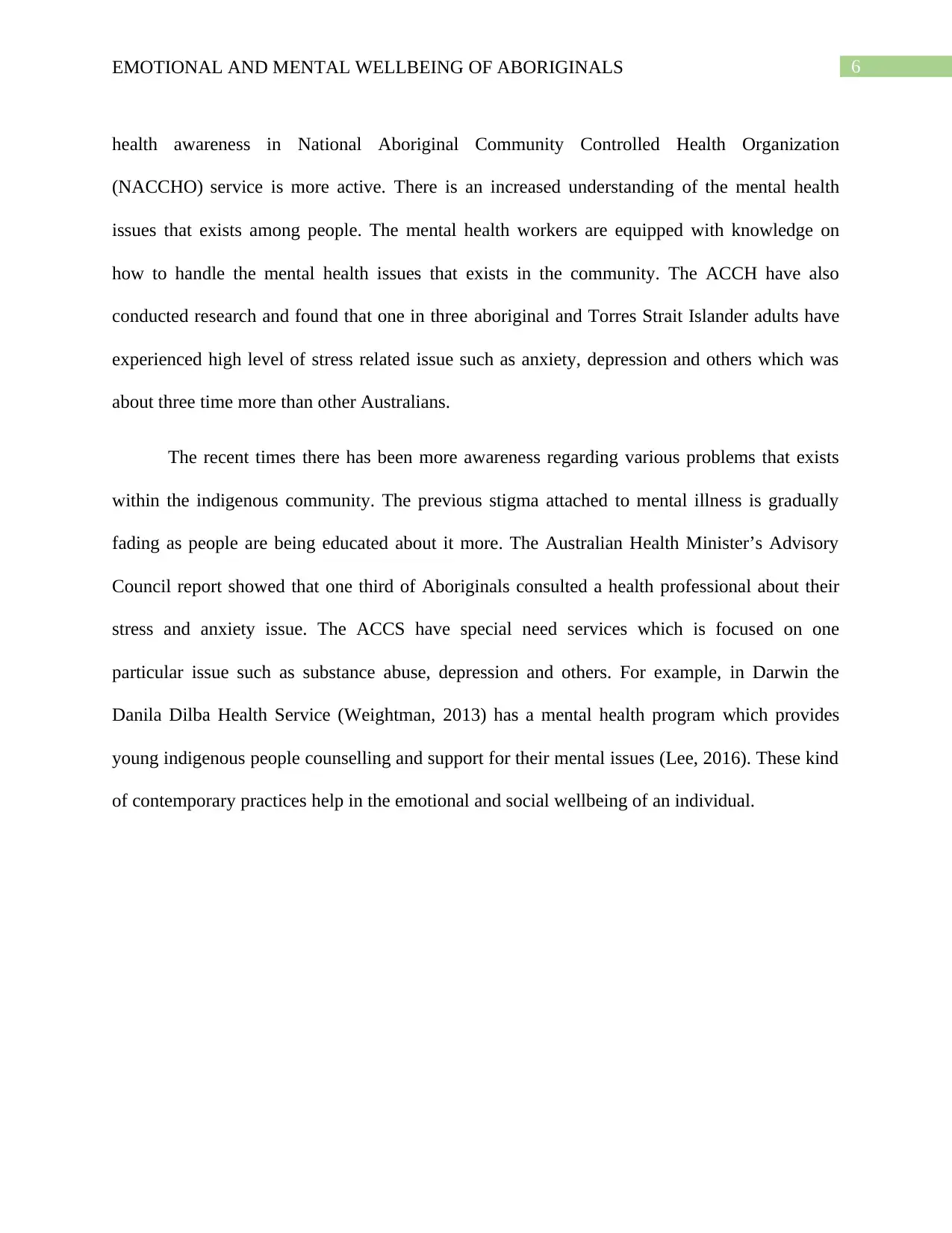
6EMOTIONAL AND MENTAL WELLBEING OF ABORIGINALS
health awareness in National Aboriginal Community Controlled Health Organization
(NACCHO) service is more active. There is an increased understanding of the mental health
issues that exists among people. The mental health workers are equipped with knowledge on
how to handle the mental health issues that exists in the community. The ACCH have also
conducted research and found that one in three aboriginal and Torres Strait Islander adults have
experienced high level of stress related issue such as anxiety, depression and others which was
about three time more than other Australians.
The recent times there has been more awareness regarding various problems that exists
within the indigenous community. The previous stigma attached to mental illness is gradually
fading as people are being educated about it more. The Australian Health Minister’s Advisory
Council report showed that one third of Aboriginals consulted a health professional about their
stress and anxiety issue. The ACCS have special need services which is focused on one
particular issue such as substance abuse, depression and others. For example, in Darwin the
Danila Dilba Health Service (Weightman, 2013) has a mental health program which provides
young indigenous people counselling and support for their mental issues (Lee, 2016). These kind
of contemporary practices help in the emotional and social wellbeing of an individual.
health awareness in National Aboriginal Community Controlled Health Organization
(NACCHO) service is more active. There is an increased understanding of the mental health
issues that exists among people. The mental health workers are equipped with knowledge on
how to handle the mental health issues that exists in the community. The ACCH have also
conducted research and found that one in three aboriginal and Torres Strait Islander adults have
experienced high level of stress related issue such as anxiety, depression and others which was
about three time more than other Australians.
The recent times there has been more awareness regarding various problems that exists
within the indigenous community. The previous stigma attached to mental illness is gradually
fading as people are being educated about it more. The Australian Health Minister’s Advisory
Council report showed that one third of Aboriginals consulted a health professional about their
stress and anxiety issue. The ACCS have special need services which is focused on one
particular issue such as substance abuse, depression and others. For example, in Darwin the
Danila Dilba Health Service (Weightman, 2013) has a mental health program which provides
young indigenous people counselling and support for their mental issues (Lee, 2016). These kind
of contemporary practices help in the emotional and social wellbeing of an individual.
Paraphrase This Document
Need a fresh take? Get an instant paraphrase of this document with our AI Paraphraser
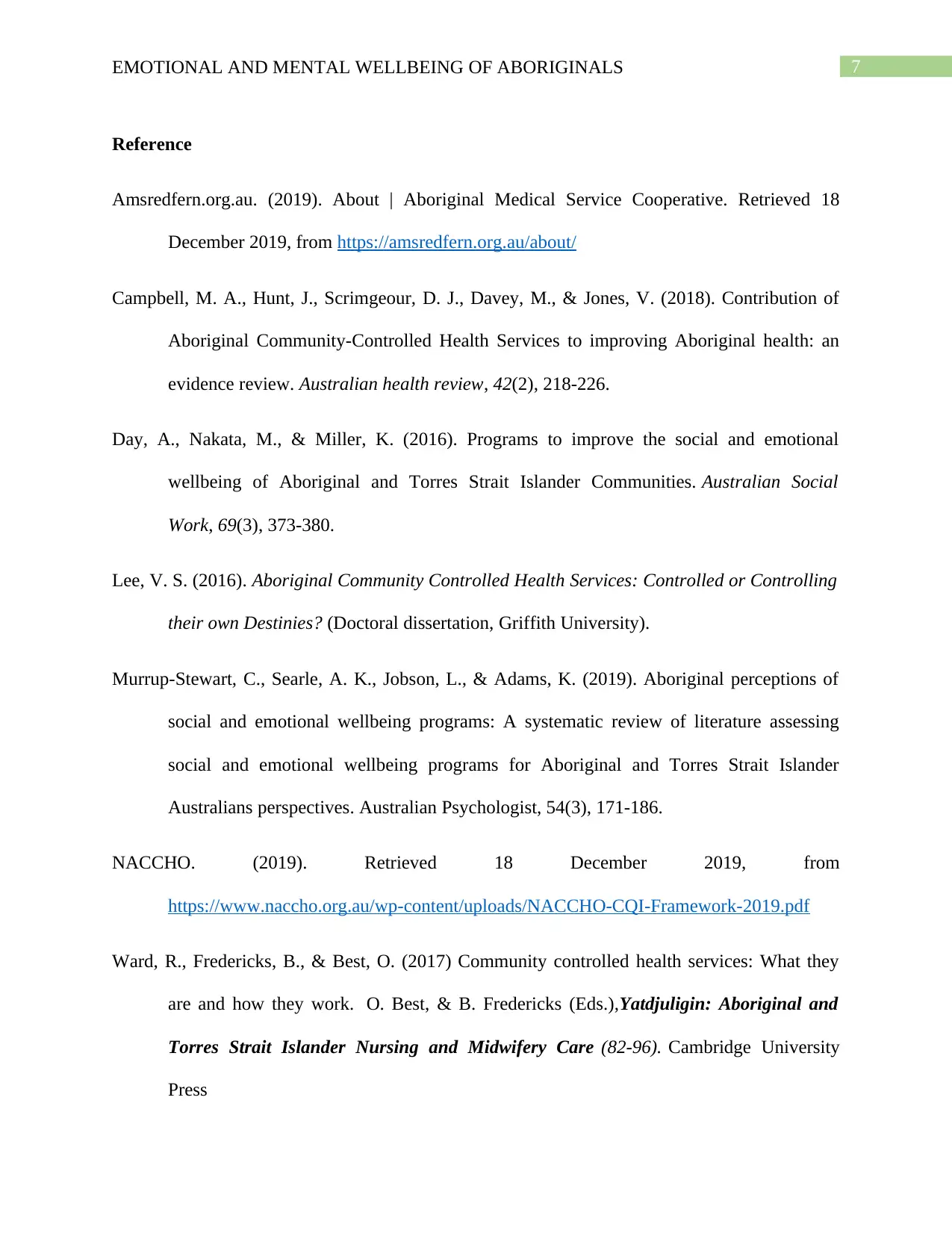
7EMOTIONAL AND MENTAL WELLBEING OF ABORIGINALS
Reference
Amsredfern.org.au. (2019). About | Aboriginal Medical Service Cooperative. Retrieved 18
December 2019, from https://amsredfern.org.au/about/
Campbell, M. A., Hunt, J., Scrimgeour, D. J., Davey, M., & Jones, V. (2018). Contribution of
Aboriginal Community-Controlled Health Services to improving Aboriginal health: an
evidence review. Australian health review, 42(2), 218-226.
Day, A., Nakata, M., & Miller, K. (2016). Programs to improve the social and emotional
wellbeing of Aboriginal and Torres Strait Islander Communities. Australian Social
Work, 69(3), 373-380.
Lee, V. S. (2016). Aboriginal Community Controlled Health Services: Controlled or Controlling
their own Destinies? (Doctoral dissertation, Griffith University).
Murrup‐Stewart, C., Searle, A. K., Jobson, L., & Adams, K. (2019). Aboriginal perceptions of
social and emotional wellbeing programs: A systematic review of literature assessing
social and emotional wellbeing programs for Aboriginal and Torres Strait Islander
Australians perspectives. Australian Psychologist, 54(3), 171-186.
NACCHO. (2019). Retrieved 18 December 2019, from
https://www.naccho.org.au/wp-content/uploads/NACCHO-CQI-Framework-2019.pdf
Ward, R., Fredericks, B., & Best, O. (2017) Community controlled health services: What they
are and how they work. O. Best, & B. Fredericks (Eds.),Yatdjuligin: Aboriginal and
Torres Strait Islander Nursing and Midwifery Care (82-96). Cambridge University
Press
Reference
Amsredfern.org.au. (2019). About | Aboriginal Medical Service Cooperative. Retrieved 18
December 2019, from https://amsredfern.org.au/about/
Campbell, M. A., Hunt, J., Scrimgeour, D. J., Davey, M., & Jones, V. (2018). Contribution of
Aboriginal Community-Controlled Health Services to improving Aboriginal health: an
evidence review. Australian health review, 42(2), 218-226.
Day, A., Nakata, M., & Miller, K. (2016). Programs to improve the social and emotional
wellbeing of Aboriginal and Torres Strait Islander Communities. Australian Social
Work, 69(3), 373-380.
Lee, V. S. (2016). Aboriginal Community Controlled Health Services: Controlled or Controlling
their own Destinies? (Doctoral dissertation, Griffith University).
Murrup‐Stewart, C., Searle, A. K., Jobson, L., & Adams, K. (2019). Aboriginal perceptions of
social and emotional wellbeing programs: A systematic review of literature assessing
social and emotional wellbeing programs for Aboriginal and Torres Strait Islander
Australians perspectives. Australian Psychologist, 54(3), 171-186.
NACCHO. (2019). Retrieved 18 December 2019, from
https://www.naccho.org.au/wp-content/uploads/NACCHO-CQI-Framework-2019.pdf
Ward, R., Fredericks, B., & Best, O. (2017) Community controlled health services: What they
are and how they work. O. Best, & B. Fredericks (Eds.),Yatdjuligin: Aboriginal and
Torres Strait Islander Nursing and Midwifery Care (82-96). Cambridge University
Press
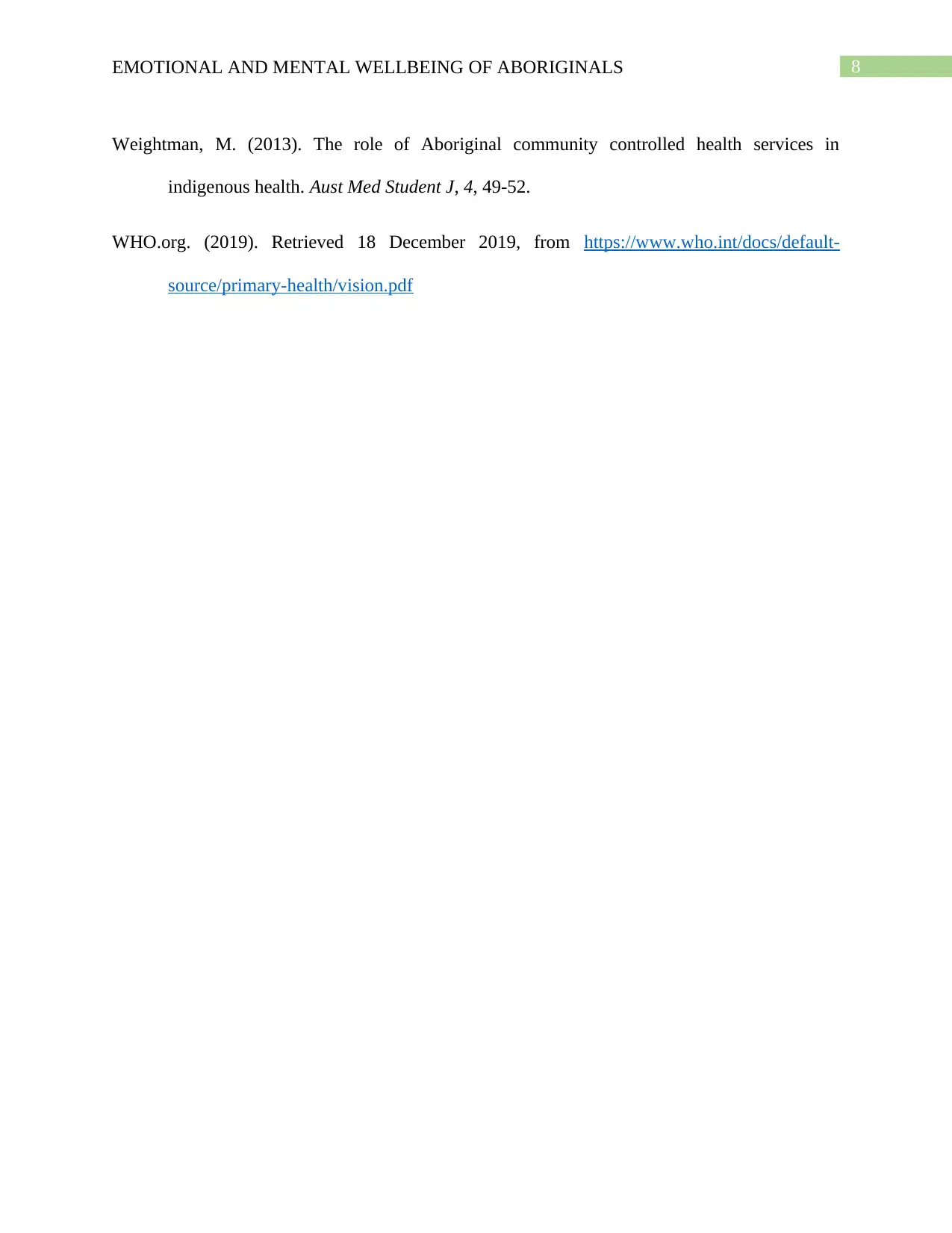
8EMOTIONAL AND MENTAL WELLBEING OF ABORIGINALS
Weightman, M. (2013). The role of Aboriginal community controlled health services in
indigenous health. Aust Med Student J, 4, 49-52.
WHO.org. (2019). Retrieved 18 December 2019, from https://www.who.int/docs/default-
source/primary-health/vision.pdf
Weightman, M. (2013). The role of Aboriginal community controlled health services in
indigenous health. Aust Med Student J, 4, 49-52.
WHO.org. (2019). Retrieved 18 December 2019, from https://www.who.int/docs/default-
source/primary-health/vision.pdf
⊘ This is a preview!⊘
Do you want full access?
Subscribe today to unlock all pages.

Trusted by 1+ million students worldwide
1 out of 9
Related Documents
Your All-in-One AI-Powered Toolkit for Academic Success.
+13062052269
info@desklib.com
Available 24*7 on WhatsApp / Email
![[object Object]](/_next/static/media/star-bottom.7253800d.svg)
Unlock your academic potential
Copyright © 2020–2025 A2Z Services. All Rights Reserved. Developed and managed by ZUCOL.





